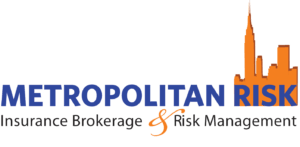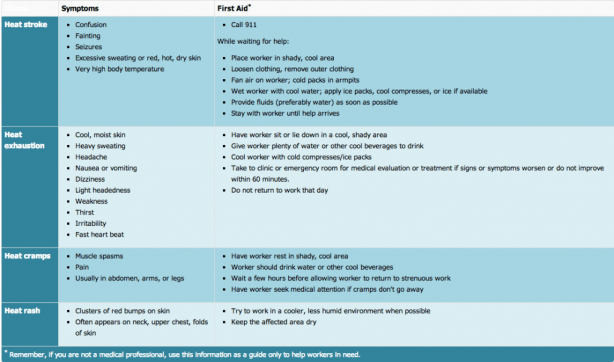We have just entered the “Dog Days of Summer,” or in other words the hottest part of the year. While protecting yourself or your employees from heat exhaustion seems like common sense, about 675 people die in the U.S. every year due to heat-related illness (Center for Disease Control & Prevention). This is tragic since heat illness is nearly 100% preventable. So here we are to remind you of these important heat illness prevention methods.
Symptoms & First Aid (Source: O.S.H.A.)
Click the image for a larger view. This helpful chart, provided by O.S.H.A, breaks down the symptoms and first aid measures for each heat-related illness.
911 should be called if symptoms of a heat stroke occur, while symptoms of heat exhaustion might not require that call.
Heat Illness Prevention
Heat-related illnesses can almost always be prevented. Important ways to reduce the risk of heat-related illness include a combination of both engineering controls and work practices.
Examples of engineering controls are air conditioning and ventilation. Work practices examples are work/rest cycles, drinking water often, and providing an opportunity for workers to build up a level of tolerance to working in the heat.
Employers should include prevention steps in worksite training. Finally, plan ahead for what to do during an emergency — acting quickly can save lives!
All Tips Below Provided By O.S.H.A
Engineering Controls
The best way to prevent heat-related illness is to make the work environment cooler. A variety of engineering controls can reduce workers’ exposure to heat:
- Air conditioning
- Increased general ventilation.
- Cooling fans.
- Local exhaust ventilation at points of high heat production or moisture (Such as exhaust hoods in laundry rooms).
- Reflective shields to redirect radiant heat.
- Insulation of hot surfaces (such as furnace walls).
- Elimination of steam leaks.
Work Practices
- Employers should have an emergency plan in place that specifies what to do if a worker is showing signs of heat-related illness, and ensures that medical services are available if needed.
- Employers should take steps to help workers gradually build up exposure to heat, especially workers who are new to working in the heat or have been away from work for a week or more. Gradually increase workloads and allow more frequent breaks during the first week of work.
- Workers must have water (safe for drinking) close to the work area, and should drink small amounts frequently.
- Workers should be allowed to ration the workload evenly over the day and incorporate work/rest cycles.
- If possible, physical demands should be reduced during hot weather, or heavier work scheduled for cooler times of the day.
- Rotating job functions among workers can help minimize overexertion and heat exposure.
- Workers should watch each other for symptoms of heat-related illness and administer appropriate first aid to anyone who is developing a heat-related illness.
- In some situations, employers may need to conduct physiological monitoring of workers
Personal Protective Equipment
Workers should be aware that use of certain personal protective equipment (such as certain types of respirators and impermeable clothing) can increase the risk of heat-related illness.
In some situations, special cooling devices can protect workers in hot environments:
- In some workplaces, insulated gloves, insulated suits, reflective clothing, or infrared reflecting face shields may be needed.
- Thermally conditioned clothing may be useful for extremely hot conditions; for example:
- A garment with a self-contained air conditioner in a backpack.
- A garment with a compressed air source that feeds cool air through a vortex tube.
- A plastic jacket whose pockets can be filled with dry ice or containers of ice.
Training
Workers and supervisors should be knowledgeable on the dangers of heat exposure and prevention. Topics should include:
Importance of:
- Drinking small quantities of water often.
- Acclimatization, how it is developed, and how your worksite procedures address it.
- Immediately reporting signs or symptoms of heat-related illness to the supervisor
- Different types of heat-related illness, including (see chart above)
- Prevention procedures
Procedures to:
- Respond to possible heat-related illness.
- Following directions when contacting emergency medical services.
- Give clear directions provided to emergency medical services








